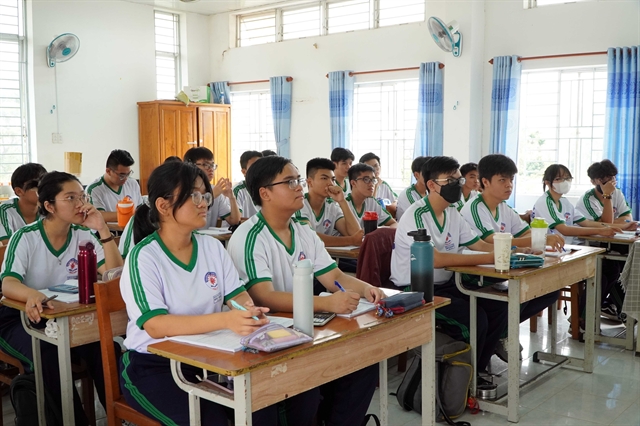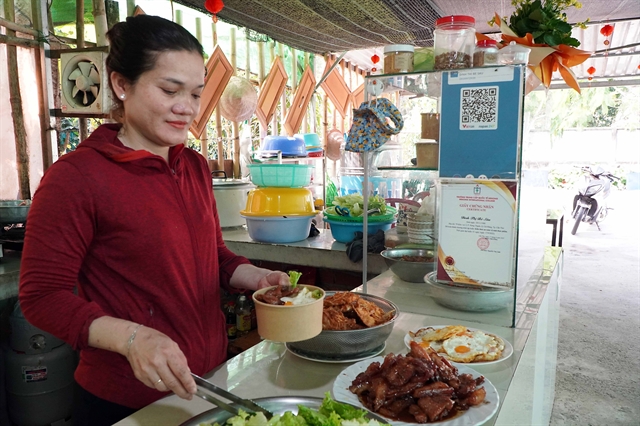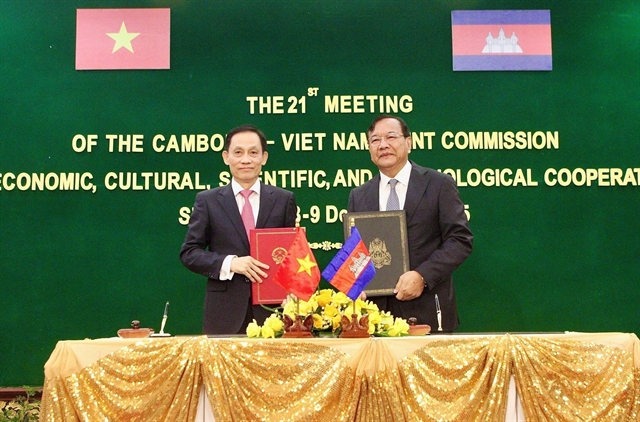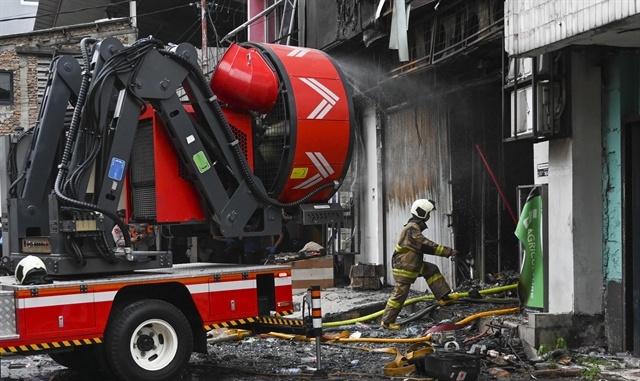.jpg) Society
Society

 |
| Students at Lý Tự Trọng High School for Gifted Students use personal water bottles instead of single-use plastic.— VNA/VNS Photo Trung Kiên |
CẦN THƠ — Ngô Nguyễn Trung Nam, a student in class 11A4 at the Lý Tự Trọng High School for Gifted Students in the Mekong Delta city of Cần Thơ, often spends 20 minutes after school to manage waste disposal.
Nam is an active member of the Zero Waste Club and the head of his class's waste sorting committee. This role means that he arrives home a little later, but he genuinely enjoys it, as he is passionate about helping maintain the school's surroundings.
Nam believes that proper waste classification is essential not only at school but also in daily life.
Võ Duy Hoàng, a student in class 12A2 and vice president of the school’s Zero Waste Club, said that one of the club's regular activities was overseeing the collection and sorting of waste in classrooms.
At the end of the school day, each class sorts and transports waste to designated collection points.
The waste is categorised into three main types: general waste, recyclables and organic waste.
Green lifestyle
In addition to waste sorting, nearly all of the students at Lý Tự Trọng High School for Gifted Students have gradually eliminated the use of items like styrofoam containers, plastic bottles and single-use plastic products.
In some classrooms, over half of the students regularly use their personal water bottles.
It has become common to see students carrying their own water bottles and lunchboxes, a visible sign of the shift in both awareness and action.
Đào Minh Ngọc, a student in class 11A5, said that every morning she carries a small fabric bag with a water bottle and a glass lunchbox.
During break time, after eating with friends, Ngọc carefully stores her lunchbox and water bottle back in the bag to wash them for the next day.
Ngọc added that she began the habit when she started studying at the school, deeply inspired by the school's green movement.
Initially, she was surprised to see so many of her peers using their personal water bottles and lunchboxes.
This prompted her to learn more, and she quickly joined the meaningful green effort.
A strong testament to the success of the school's green initiative is the way local businesses nearby are gradually adopting environmentally friendly practices to align with the student movement.
Several businesses, previously reliant on traditional items like styrofoam containers and plastic bags, have now added paper boxes, bags and cups to serve the students.
 |
| The owner of a food stall near Lý Tự Trọng High School for Gifted Students uses paper packaging to serve the students. — VNA/VNS Photo Trung Kiên |
Đinh Thị Bé Sáu, 38, the owner of a food stall near the school, said that a few years ago, she realised that the number of student customers at her stall had declined.
After learning about the students’ commitment to the green movement, which encourages reducing single-use plastics, she realised that her use of styrofoam containers was no longer appealing to them.
In response, she started offering paper containers. Inspired by the students, she now exclusively uses paper packaging at her stall.
Zero waste club
In 2018, the school faced a challenging waste problem. On windy days, the school grounds became littered with trash blown around by the wind. The primary cause was identified as the large amount of waste generated by students, which led to overflowing bins.
In response to the issue, the school’s Youth Union devised a plan to reduce plastic waste and raise environmental awareness. The initiative received strong support from the school’s management.
The focal point of the plan was the creation of the Zero Waste Club, which aimed to instil environmental consciousness among the students. The club’s name reflects its mission. It aims to promote a lifestyle that generates little to no waste, contributing to environmental protection.
The club is also commonly referred to as the 'Green Life' initiative.
Nguyễn Hoài Thanh, secretary of the school’s Youth Union, said that an interesting aspect of the school's green movement is the absence of rigid rules.
Waste sorting at source has become an everyday activity, allowing students to confront the waste they generate, which helps them adjust their habits.
A friendly competition in environmental consciousness has unfolded naturally, with no penalties for violations -- but those who excel are recognised and rewarded with points for their efforts.
However, the journey had not always been smooth, he said.
Thanh recalled that initially, many parents expressed concerns about the inconvenience of preparing breakfast for their children instead of buying a quick takeaway meal.
Nevertheless, through persistence, the club and the school gradually overcame the challenges, reinforcing the idea that environmental protection is a long-term commitment that requires everyone's cooperation.
Today, many parents are fully supportive of the initiative, recognising that it not only benefits the environment but also promotes the health of their children.
In December 2024, the school was honoured to be one of only six institutions nationwide to be recognised by the Việt Nam Association for Conservation of Nature and Environment for meeting the criteria of the 'National Green Environment' programme.
Lư Thị Ngọc Anh, secretary of the city’s Youth Union, said that initiatives like the one at the school were important for spreading awareness and inspiring other schools.
The city’s Youth Union values the strong, coordinated efforts from the school’s management, the school’s Youth Union and especially the active participation of the students.
The students have demonstrated that environmental protection is a shared responsibility, and even the smallest actions and habits can contribute to the cause.— VNS




